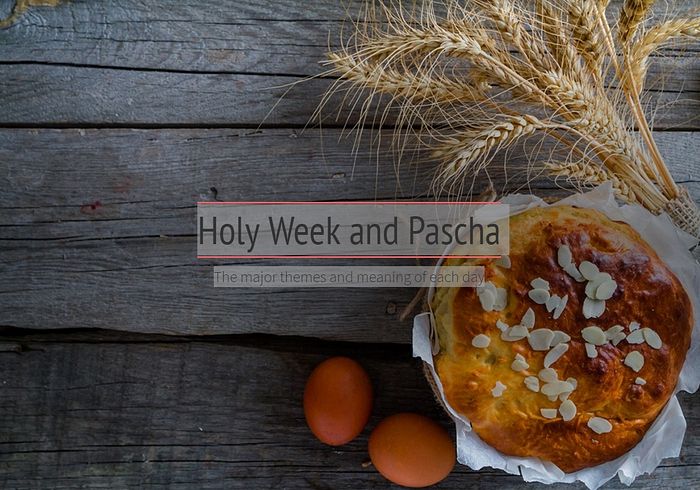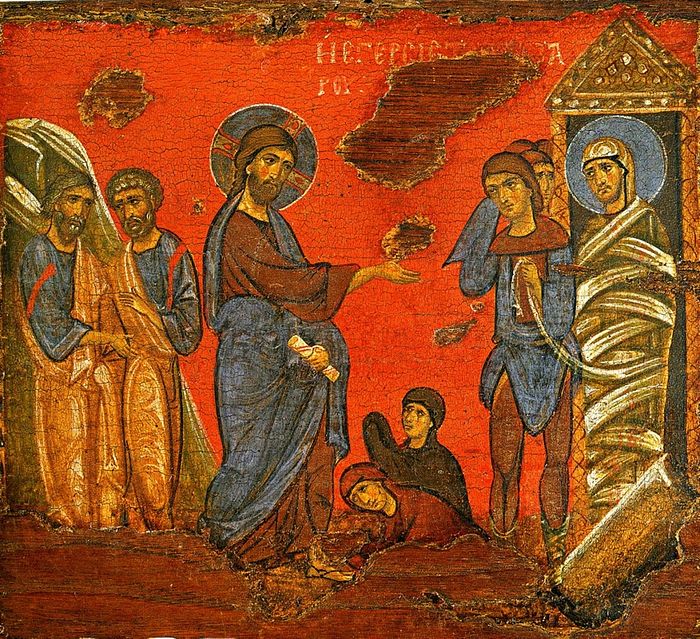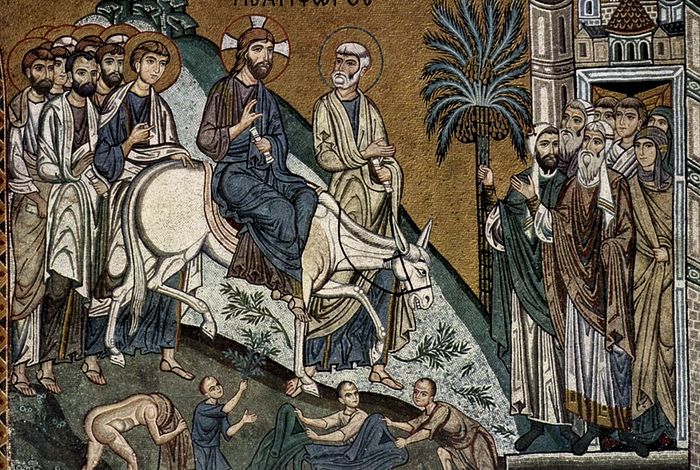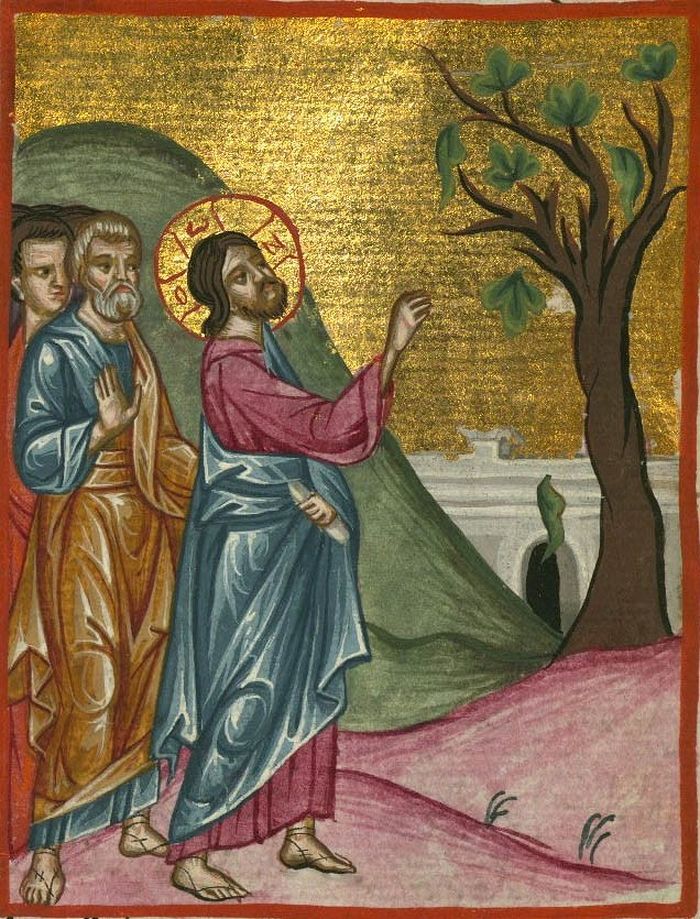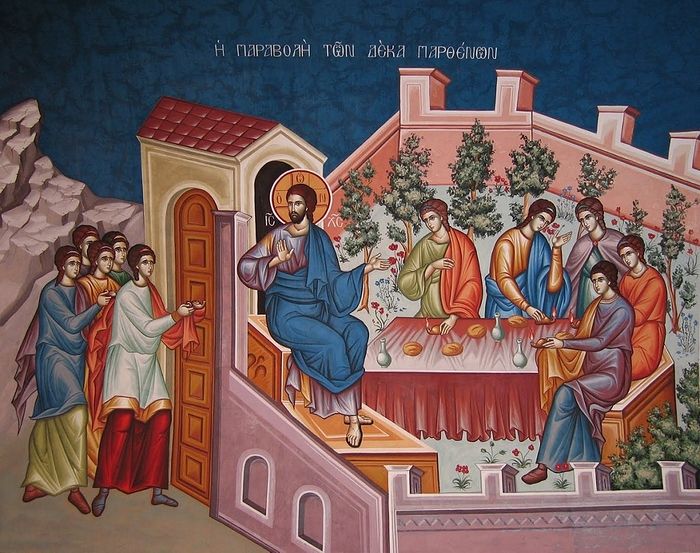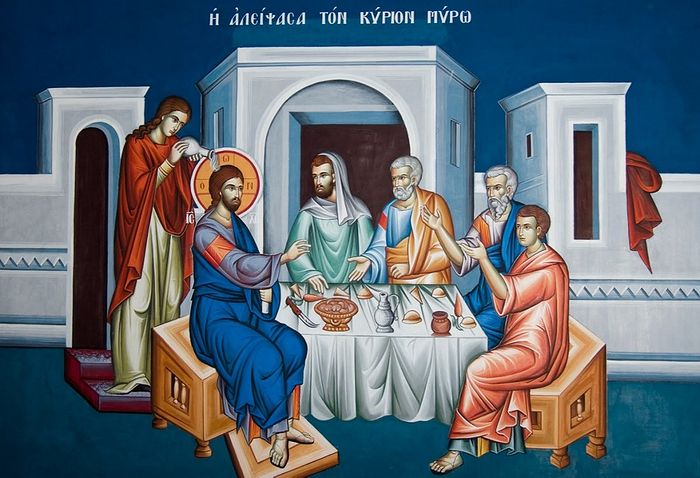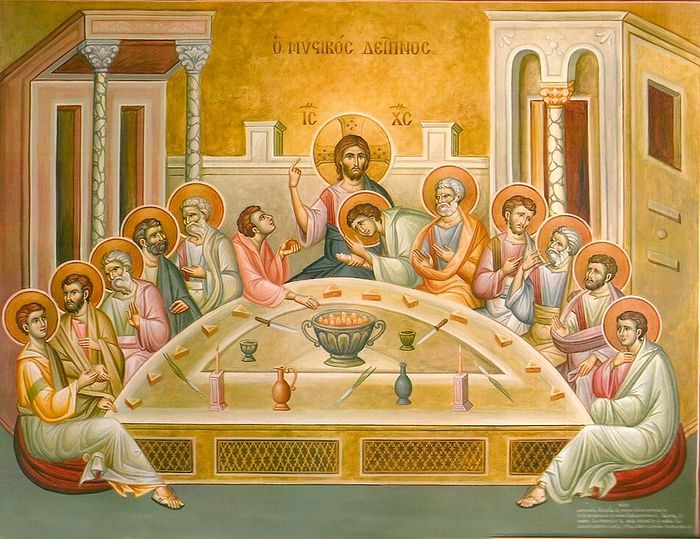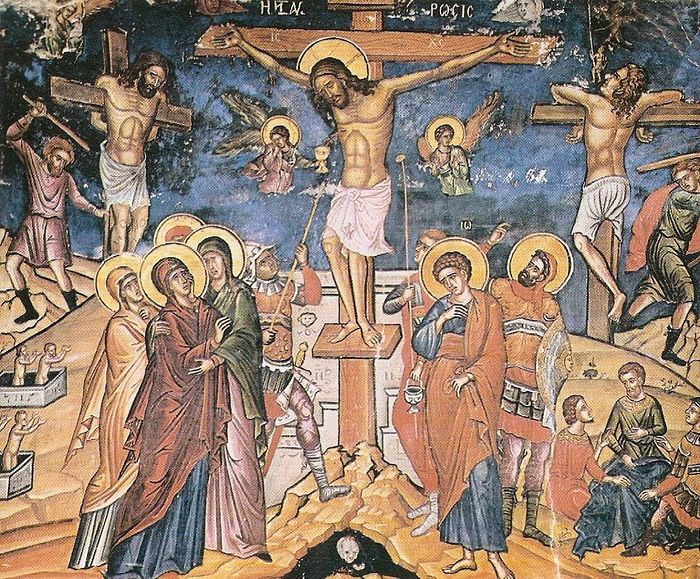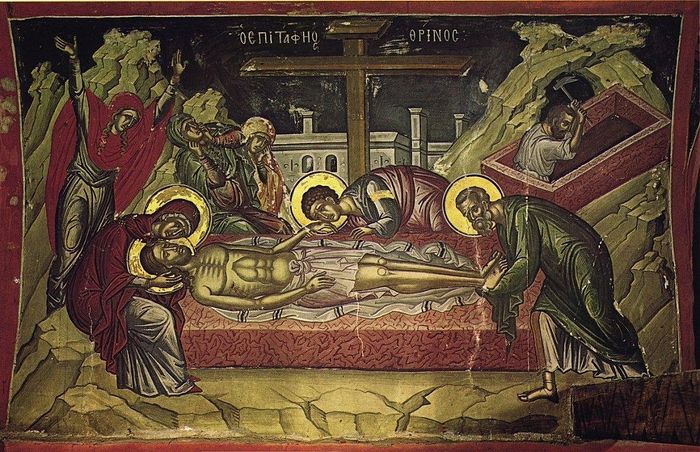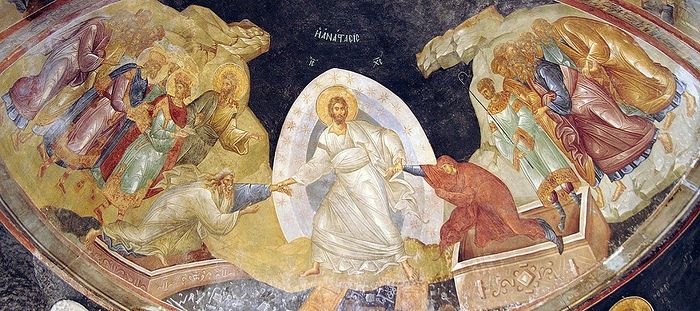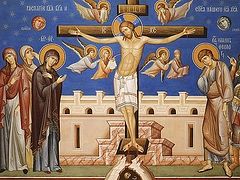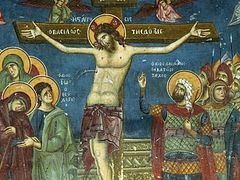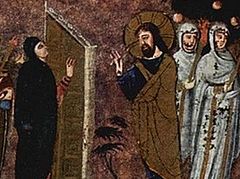Great Lent and Holy Week are two separate fasts, and two separate celebrations. Great Lent ends on Friday of the fifth week (the day before Lazarus Saturday). Holy Week begins immediately thereafter. Let's explore the meaning of each of the solemn days of Passion Week.
SATURDAY OF LAZARUS
On this day, the Saturday before Palm Sunday, we celebrate the raising of the holy and righteous friend of Christ, Lazarus, who had been four days in the grave.
"Having fulfilled Forty Days... we ask to see the Holy Week of Thy Passion." With these words sung at Vespers of Friday, Lent comes to its end and we enter into the annual commemoration of Christ's suffering, death and Resurrection. It begins on the Saturday of Lazarus. The double feast of Lazarus' resurrection and the Entrance of the Lord to Jerusalem (Palm Sunday) is described in liturgical texts as the "beginning of the Cross" and is to be understood therefore, within the context of the Holy Week. The common Troparion of these days explicitly affirms that by raising Lazarus from the dead Christ confirmed the truth of general resurrection. It is highly significant that we are led into the darkness of the Cross by one of the twelve major feasts of the Church. Light and joy shine not only at the end of Holy Week but also at its beginning. All those familiar with Orthodox worship know the peculiar, almost paradoxical character of Lazarus Saturday services. It is a Sunday, i.e., a Resurrection, service on a Saturday, a day usually devoted to the liturgical commemoration of the dead. And the joy which permeates these services stresses one central theme: the forthcoming victory of Christ over Hades. Hades is the Biblical term for. It is that unescapable darkness and destruction that swallows all life and poisons with its shadow the whole world. But now -- with Lazarus' resurrection -- "death begins to tremble." For there the decisive duel between Life and Death begins and it gives us the key to the entire liturgical mystery of Pascha. In the early church Lazarus Saturday was called "announcement of Pascha", it announces and anticipates, indeed, the wonderful light and peace of the next Saturday - the Great and Holy Saturday, the day of the Lifegiving Tomb.
Listen: Lazarus Saturday Apolytikion
PALM SUNDAY
On this day, Palm Sunday, we celebrate the resplendent and glorious feast of the entry of our Lord, God and Savior Jesus Christ into Jerusalem.
Palm Sunday celebrates the glorious and brilliant feast of the Entrance of Jesus into Jerusalem (John 12:1-18). Zechariah had prophesied the entrance of the Messiah into Jerusalem, saying: “Rejoice greatly … O daughter of Jerusalem; behold, the King comes unto Thee; he is just, and having salvation; lowly, and riding upon an ass, and upon a colt the foal of an ass”, Zech. 9:9. The contemporary Jews associated this prophecy with the expected Messiah. This action of Christ testifies to His nature as Messiah, but with the definite declaration that His Kingdom was not of this world. The main road leading to Jerusalem was covered with palm trees. The multitudes, with palm branches in their hands, spread their cloaks on the road as a show of respect, crying out “Hosanna to the Son of David. Blessed is He that comes in the name of the Lord.” A custom of distributing branches of palms to the people in the Church prevails to this day.
During the remainder of Holy Week, the Church advances its liturgical life by about twelve hours, celebrating morning services the night before, and evening services in the morning.
On Palm Sunday evening, the Church celebrates the Orthros (Matins) of Holy Monday, in the first of four “Bridegroom Services.” Christ is called the “Bridegroom” because in His Passion, He gives His life for His Bride, the people of God, the Church, just as a husband will sacrifice everything for his wife and family.
Listen: Palm Sunday Apolytikion
HOLY AND GREAT MONDAY
On great and holy Monday we commemorate blessed Joseph the handsome; and also the fig tree that was cursed by the Lord and then withered.
In the Orthros of Holy Monday,celebrated Palm Sunday evening, the Church remembers the blessed and noble Joseph and the fig tree which was cursed and withered by the Lord.
Listen: Exapostilarion of Bridegroom Service
Video: Holy Monday Bridegroom Monday Service
HOLY AND GREAT TUESDAY
On great and holy Tuesday, we commemorate the parable of the ten virgins from the holy Gospel.
In the Orthros of Holy Tuesday, celebrated Holy Monday evening, the Church remembers the parable of the Ten Virgins (Matthew 25:1-13), who were waiting for the arrival of the Bridegroom at a wedding feast.
Video: Holy Tuesday Bridegroom Service
HOLY AND GREAT WEDNESDAY
On great and holy Wednesday, as the most divine fathers ordained, we commemorate the harlot who anointed the Lord's feet with fragrant ointment, since this occurred shortly before the saving Passion.
In the Orthros of Holy Wednesday celebrated on Holy Tuesday evening, the Church remembers the anointing of Christ with myrrh by the woman in the house of Simon, the leper, in Bethany. This woman demonstrated her repentance and her warm faith toward our Lord. On this evening we hear the beautiful Hymn of Kassiane, which is a hymnological reflection on the repentance of this woman.
The Sacrament of Holy Unction
The Sacrament of Holy Unction takes place on Holy Wednesday evening. The Sacrament is for the healing of body and soul. In Orthodox thought, healing is connected to repentance, confession, and the remission of sins by the Lord. Holy Unction is the for cleansing sins and renewing the body and the spirit of the faithful. Holy Unction is one of the seven Sacraments of the Church, and it has its origin in the practice of the early Church as recorded in the Epistle of James (5:14-15). At the end of the service, the priest anoints the people with Holy Oil.
The Matins of Holy Thursday
In the Orthros of Holy Thursday, celebrated on Holy Wednesday evening, the Church remembers the washing of the disciples’ feet, the institution of the Holy Eucharist, the Prayer of Christ at the Last Supper as recorded in the Gospel of John, and the betrayal.
Listen: The Hymn of Saint Kassiani
Video: The Sacrament of Holy Unction
HOLY AND GREAT THURSDAY
On holy and great Thursday the godly Fathers, who have arranged all things well, received from the divine Apostles and the sacred Gospels and in turn handed down to us, that today we should celebrate four things: the sacred Washing of Feet, the Mystical Supper (that is, the tradition of what we know as the awesome Mysteries of Holy Communion), the High Priestly Prayer, and finally the Betrayal itself.
In the morning, the Vesperal Divine Liturgy of St. Basil the Great is celebrated. At this Divine Liturgy, the Church commemorates the institution of the Holy Eucharist by the Lord at His Last Supper with His disciples. Here, Christ presented bread and wine as His body and blood, which form the core of the new covenant between God and His people, the Church.
In the evening, in the Orthros of Holy Friday, the Church recalls the Passion of the Lord, from His betrayal by Judas Iscariot, His agony and arrest at Gethsemane, His trial by Jewish religious leaders and Roman authorities, His beatings and mocking, and crucifixion and death on the Cross. This service is long, with twelve readings from the Gospels recounting the events, but its content is dramatic and moving. After the reading of the fifth Gospel comes the procession with the icon of the Crucified Christ around the church.
Video: Holy Thursday Evening Service
Text of Divine Litrugy of Saint Basil the Great
HOLY AND GREAT FRIDAY
On this day, Holy and Great Friday, we celebrate the awesome, holy, and saving Passion of our Lord and God and Savior Jesus Christ: the spitting, the blows, the buffeting, the mockery, the reviling, the purple robe, the reed, the sponge, the vinegar, the nails, the spear, and above all, the Cross and Death which He condescended to endure willingly for our sakes. Also the saving confession on the cross of the grateful Robber who was crucified with Him.
In the morning, the four “Royal Hours” are read. These services consist of hymns, psalms, and readings from the Old and New Testaments, all related prophetically and ethically to the Person of Christ.
Usually in mid-afternoon, Great Vespers is chanted. During this service, we hear the story of the Crucifixion, but with attention paid to the death of Christ, the work of Joseph of Arimathea to secure the body of Christ from Pilate, His removal from the cross, and His burial.
At one point in the reading, the Body of Christ is removed the cross, wrapped in a white cloth and is brought into the sanctuary. Following the reading, the priest carries the icon of the Epitaphios through the church and places it in the Sephulchre (the kouvouklion), which has been decorated with flowers.
Holy and Great Friday evening – THE LAMENTATIONS
On Holy Friday evening, we sing the Orthros of Holy Saturday, consisting of psalms, hymns and readings, dealing with the death of Christ. During the Orthros, the congregation will join in chanting the Lamentations, hymns of praise to the Lord and relating His ultimate triumph over death. During this service the Epitaphios icon is carried in procession around the church. In some parishes the entire flower-bedecked Sepulcher, symbolizing the Tomb, is carried in the procession.
Video: The Great and Royal Hours
Video: The Descent from the Cross Service
HOLY AND GREAT SATURDAY
On great and holy Saturday, we celebrate the burial of the divine Body and the descent into Hades of our Lord and Savior Jesus Christ, through which He recalled our human race from corruption and passed it over into life eternal.
On Holy Saturday morning, the Vesperal Divine Liturgy is celebrated. In this Liturgy, the Resurrection of Christ is celebrated and the triumph over death is proclaimed in the hymns and the readings from the Old and New Testament. There is a strong theme of baptism in this liturgy, because in the ancient Church, the catechumens would be baptized in this evening vigil of Pascha.
Holy and Great Saturday night- The Resurrection Service
At midnight Saturday, the life-giving Resurrection of our Lord and Savior Jesus Christ is celebrated. Before midnight, the Odes of Lamentation of the previous day are repeated. The Orthros of the Resurrection begins in complete darkness. The priest takes light from the vigil light and gives it to the faithful, who are holding candles. The priest sings, “Come, receive light from the unwaning light, and glorify Christ, who arose from the dead.” Just a short while later, the priest reads the resurrection story from the Gospel of Mark (16:1-8) and leads the congregation in singing the Resurrection Hymn, Christ is risen from the dead, trampling death by death, and to those in the tombs bestowing life.” Following, the Orthros service continues and leads into the celebration of the Divine Liturgy.
Video: Holy Saturday Morning Service
Video: The Service of Resurrection
Text of Divine Liturgy of Saint Basil the Great
HOLY AND GREAT SUNDAY OF PASCHA
On the holy and great Sunday of Pascha we celebrate the very life-bearing Resurrection of our Lord and God and Savior Jesus Christ.
THE AGAPE VESPERS
At some point on Sunday afternoon the faithful gather once more for Great Vespers, With lighted candles they sing, “Christ is risen. ” The people greet one another with the salutation, “Christ is Risen”, which is answered, “Truly He is Risen”. In the Great Vespers, the Gospel according to John (20:19-25) is read in various languages, proclaiming the Good News of Resurrection all over the universe without discrimination. The fruit of faith in the Resurrection of the Lord is love in His Name; therefore, this day is called “Sunday of Agape.”
For the next forty days, the Orthodox Church commemorates the Resurrection of Christ.

